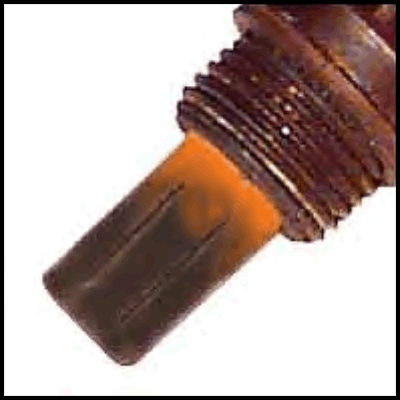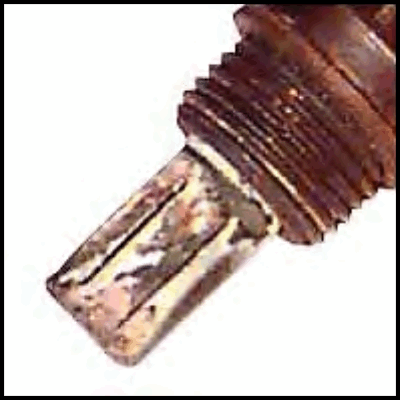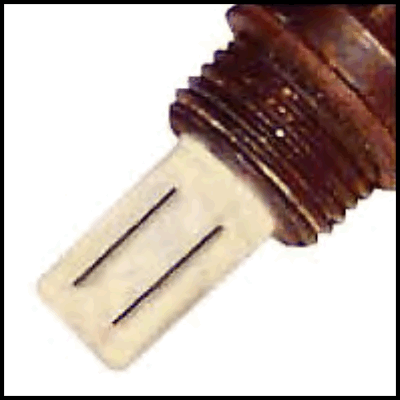Lambda Sensor Common Faults

Lead Poisoning

Ethylene Glycol
(Antifreeze Contamination)

Rich Fuel Mixture

Silicone Poisoning
The life expectancy of a lambda sensor is approximately 31,000 miles for unheated sensors and 62,000 miles for heated sensors. Even under normal operating conditions, lambda sensors must endure a constant barrage of harmful exhaust gases, extreme heat and high velocity particulates. Longevity of lambda sensors in older vehicles may be reduced due to worn piston rings and valves.
Sometimes lambda sensors can become contaminated by coolant, oil or silicone particulates. Lambda sensors exposed to these contaminates will not operate as designed. Although sensors in some applications can remain serviceable up to 93,000 miles, the effectiveness of lambda sensors will inevitably decrease over time.
At Walker Products, we recognize the need to keep vehicles running clean. A bad lambda sensor can cause unacceptable emissions levels, affect performance and ultimately damage the catalytic converter. Make it a point to check lambda sensors at each tune-up and replace faulty sensors with a new Walker lambda sensor.
MALFUNCTIONING AND FAILED SENSORS
Lambda sensors can fail when the sensor’s ceramic element is exposed to certain types of silicone compounds or when an oil-burning engine leads to the sensor becoming oil-fouled . Also, a small amount of tetra-ethyl lead in the gasoline can kill a lambda sensor . Over-the-counter fuel additives, which are not “lambda sensor safe” can also kill a lambda sensor.
Failures can occur either instantaneously at the time the contaminant contacts the lambda sensor, causing a dead sensor, or gradually over a period of time . Gradual deterioration results in a “slow” sensor which does not react as quickly as it should, causing the catalytic converter to perform less efficiently . This can lead to premature failure of the catalytic converter.
“Slow” lambda sensors can cause a drop in fuel economy of 10-15% and cause excessive exhaust emissions and poor drivability. Unfortunately, the symptoms of a “slow” lambda sensor are not always obvious to the vehicle owner, unless the vehicle fails an emissions test, a decline in fuel economy is noticed, or drivability problems occur.
A “dead” sensor can be detected with a relatively inexpensive digital volt-ohmmeter . A “slow” sensor can only be diagnosed by using a digital oscilloscope or scope meter . Most installers will probably not be able to spot a lambda sensor problem until it is too late, and the catalytic converter is already well on its way to failure.
Preventive Maintenance
One-wire and two-wire “unheated” type lambda sensors should be checked or replaced every 50,000 km . These sensors rely solely on hot exhaust gas to heat up to operating temperature, and are designed to allow a large volume of exhaust gas to make contact with the active ceramic element . These sensors are exposed to contamination, especially the “wide-slot” varieties found on Chrysler, Ford and General Motors vehicles.
“Heated” type lambda sensors have a built-in heater which heats the sensors . Much less exhaust gas needs to contact the ceramic element, making these sensors less prone to contamination .
“Heated” type sensors can also be located further downstream (closer to the catalytic converter) which increases their life expectancy . “Heated” type lambda sensors should be checked or replaced every 100,000 km .
OEMs We Supply Replacement Parts For:-
- AUDI
- CHRYSLER
- DODGE
- FIAT
- FORD
- HONDA
- HYUNDAI
- JAGUAR
- JEEP
- KIA
- LANCIA
- LEXUS
- MAZDA
- MERCEDES-BENZ
- MITSUBISHI
- NISSAN
- OPEL
- PORSCHE
- RENAULT
- SKODA
- SUBARU
- TOYOTA
- VAG



